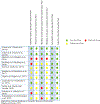A systematic review of transcranial direct current stimulation effects in attention-deficit/hyperactivity disorder
- PMID: 32697687
- PMCID: PMC8128973
- DOI: 10.1016/j.jad.2020.06.054
A systematic review of transcranial direct current stimulation effects in attention-deficit/hyperactivity disorder
Abstract
Background: Attention-deficit/hyperactivity disorder (ADHD) stands out as the most prevalent neurodevelopmental disorder of childhood, with global prevalence ranging from 3.4% to 7•2%. Its cognitive symptoms result from the combination of complex etiological processes encompassing genetic and environmental components. Available therapeutic approaches are associated with significant challenges such as modest efficacy or side effects. Transcranial direct current stimulation (tDCS) is a promising tool for enhancing cognitive performance in neuropsychiatric disorders. Trials investigating its applicability in ADHD have showed propitious, however, still preliminary findings.
Methods: We performed a systemic review by searching on Medline, Cochrane Library, Web of Science, ScienceDirect and Embase using the descriptors: "attention-deficit/hyperactivity disorder" or "ADHD"; and "transcranial direct current stimulation" or "tDCS"; following PRISMA guidelines.
Results: A total of 383 articles were identified. After removing duplicates, 45 studies were assessed for eligibility, and after careful review, 11 manuscripts applying tDCS in ADHD were included. Significant improvements in attention, inhibitory control and working memory were reported, in addition to increased brain connectivity following use of active tDCS.
Limitations: The main limitation was the small number of trials investigating use of tDCS in ADHD. Study methods and outcome measures were quite variable, and generally did not include long-term follow-up.
Conclusions: Although the extent literature indicates promising findings, the available data remains highly preliminary. Further trials evaluating the efficacy of tDCS for ADHD, with longer follow-up, are necessary. These studies will be needed to determine the optimal protocol for clinical efficacy.
Keywords: Attention; Attention-deficit/hyperactivity disorder; Inhibitory control; Prefrontal cortex; Transcranial direct current stimulation; Working memory.
Copyright © 2020. Published by Elsevier B.V.
Conflict of interest statement
CONFLICTS OF INTEREST
The authors have no conflict of interests to report.
Figures
References
-
- Arnsten AF, Li BM, 2005. Neurobiology of executive functions: catecholamine influences on prefrontal cortical functions. Biol Psychiatry 57, 1377–1384. - PubMed
-
- Arul-Anandam AP, Loo C, Mitchell P, 2010. Induction of hypomanic episode with transcranial direct current stimulation. J ECT 26, 68–69. - PubMed
Publication types
MeSH terms
Grants and funding
LinkOut - more resources
Full Text Sources
Medical



